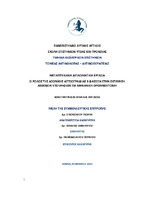Ο Ρόλος της Αξονικής Αγγειογραφίας 3 Φάσεων στην εκτίμηση ασθενών υποψηφίων για Μηχανική Θρομβεκτομή
The key role of dynamic cta of the brain for the evaluation of clinical candidates for mechanical thrombectomy

Μεταπτυχιακή διπλωματική εργασία
Συγγραφέας
Κωνσταντινίδης, Μιχαήλ
Ημερομηνία
2023-12-18Επιβλέπων
Κεχαγιάς, ΔημήτριοςΛέξεις-κλειδιά
Μηχανική θρομβεκτομή ; NIHSS ; ASPECTS ; Time is Brain ; Αξονική Αγγειογραφία 3 Φάσεων ; Λεπτομηνιγγικές αναστομώσεις ; Διάχυση ; Αιμάτωση ; Ιχνηθέτηση ΠρωτονίωνΠερίληψη
Το εγκεφαλικό επεισόδιο αποτελεί την κυριότερη αιτία για αναπηρία στους ενήλικες και
από τις βασικότερες αιτίες θανάτου στις ηλικίες άνω των 60 ετών. Η μηχανική θρομβεκτομή
αποτελεί μία αποτελεσματική θεραπεία σε ασθενείς με οξύ ισχαιμικό αγγειακό εγκεφαλικό
επεισόδιο. Ο κύριος στόχος της μηχανικής θρομβεκτομής είναι η έγκαιρη αφαίρεση του
θρόμβου και η άμεση επαναιμάτωση του αποφραγμένου αγγείου που συμβάλλει στην
καλή πρόγνωση και βελτίωση της ποιότητας ζωής των ασθενών. Ωστόσο, δεν μπορούν όλοι
οι ασθενείς να υποβληθούν στην διαδικασία της μηχανικής θρομβεκτομής. Στην κλινική
πράξη, παγκοσμίως, έχουν θεσμοθετηθεί κριτήρια για την κατηγοριοποίηση των ασθενών
που δύνανται να υποβληθούν σε μηχανική θρομβεκτομή. Τα κριτήρια βασίζονται σε κλινικά
ευρήματα κατά την νευρολογική εξέταση(NIHSS Score), καθώς και σε απεικονιστικά μετά
από την διενέργεια αξονικής τομογραφίας εγκεφάλου χωρίς χορήγηση ενδοφλέβιου
σκιαγραφικού (ASPECT Score). Ταυτόχρονα, σημαντική παράμετρος για την είσοδο ή όχι
του ασθενούς στον αγγειογράφο για την διενέργεια μηχανικής θρομβεκτομής είναι ο
χρόνος (Time Is Brain). Το εύρος του νευρολογικού παραθύρου εξαρτάται από το φραγέν
αγγείο.
Η αξονική αγγειογραφία 3 φάσεων αποσκοπεί στην ανάδειξη του φραγέντος αγγείου, στην
απεικόνιση του ύψους του θρόμβου κατά την πορεία του αγγείου, στο ακριβές μήκος του
θρόμβου καθώς και στο ποσοστό στένωσης του αγγείου. Επίσης, μας δείχνει, από την
ύπαρξη ή όχι λεπτομηνιγγικών αναστομώσεων, την δυνατότητα επανάφορας της
αιμάτωσης του πληγέντος εγκεφαλικού ιστού, μετά την μηχανική θρομβεκτομή.
Μελετήθησαν τα περιστατικά κατά το χρονικό διάστημα 1 έτους (03/22-03/23) που
προσήλθαν στον αξονικό τομογράφο του Κοργιαλλενείου-Μπενακείου Ν.Ε.Ε.Σ. με το
ερώτημα της πιθανής μηχανικής θρομβεκτομής καθώς και σε πόσα από αυτά διενεργήθηκε
τελικά μηχανική θρομβεκτομή.
Στην κλινική πράξη και στην διεθνή βιβλιογραφία θα συναντήσουμε και άλλες τεχνικές για
την εκτίμηση των ασθενών προ της μηχανικής θρομβεκτομής. Αυτές είναι η μαγνητική
τομογραφία με την χρήση των ακολουθιών διάχυσης (DWI) και ιχνηθέτησης πρωτονίων
(ASL) καθώς και η αξονική τομογραφία αιμάτωσης (CTP). Έγινε συγκριτική μελέτη των
διαφόρων τεχνικών και εξήχθησαν χρήσιμα συμπεράσματα.
Περίληψη
Stroke is the primary reason for incapability and one of the primary reasons for death in the
population above 60 years of age. Mechanical thrombectomy is a decisive cure for patients
with acute stroke. The main aim of mechanical thrombectomy is the rapid removal of the
clot and the recanalization of the vessel so that the patient could receive better prognosis
and improve the quality of life, after the procedure. Nevertheless, not all the patients can
be subdued to mechanical thrombectomy. During the clinical trials, worldwide, rankings and
scorings have been inserted for the categorization of the patients in order to proceed to
mechanical thrombectomy. Those scorings vary from the clinical tests (NIHS Score), to the
results after performing non enhanced CT scan of the brain (ASPECT Score). At the same
time, a very critical parameter for the decision for mechanical thrombectomy is the timing
(Time is Brain). By saying this, we mean the exact time from the beginning of the symptoms
until the entrance of the patient to a dedicated stroke center. The opening of the
neurological window of time depends on the vessel that has been blocked.
The main aim of the 3-phase cta of the brain is to visualize the blocked vessel, to find the
exact place of the clot into the vessel, to find the exact volume of the clot and to determine
the percentage of the blockage of the vessel. At the same time, it is shown at the same
examination, the presence or the non-presence of collateral leptomeningeal anastomoses.
This is a sign of the success of the mechanical thrombectomy for the benefit of a better life
quality of the patient. This study covered the period of one year, from 2022/03 until
2023/03, of patients that came to the ER at the hospital of the Hellenic Red Cross with the
clinical sign of acute stroke and to see the number of how many of them continued to
mechanical thrombectomy.
At the clinical act and through a systematic literature review of medical data, we came
across other techniques to investigate and appreciate the outcome of a clot. These
techniques are the magnetic resonance imaging with the use of diffusion and arterial spin
labelling sequences and perfusion computerized tomography. A comparative study of all the
techniques has been made and usefull findings have been exported.

